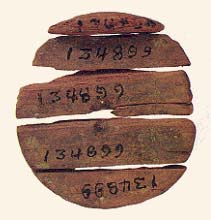Image Details

Smithsonian Institute, Catalogue No. 134899, Dept. of Anthropology
Crucial evidence. These wooden fragments and others, identified as the remains of indigenous earspools, also lay under the skull with the inscribed stone and the brass bracelets. Copper salts from the bracelets, visible as green stains, may have helped to preserve the wood.
Too little wood remained to test it by the old radiocarbon dating method in 1970, when Cyrus Gordon proposed his decipherment of the inscription. Since then, however, a new method of radiocarbon dating, useable on much smaller samples, has been developed.
When a sample from the Bat Creek earspools was tested in 1988, it yielded a dating of 427 A.D., with a 95 percent confidence range of 32 to 769 A.D. (The large range of dates resulted from the small size of the sample tested.) This dating, when applied to the associated bracelets, argues for a pre-Columbian Old World contact even if no inscription had been found.
